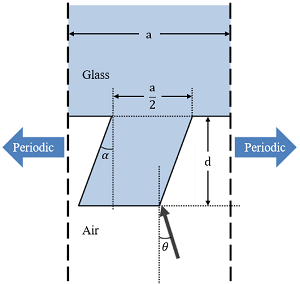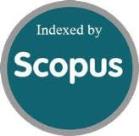Diffractive Efficiency Prediction of Surface Relief Grating Waveguide Using Artificial Neural Network
DOI:
https://doi.org/10.46604/ijeti.2024.13434Keywords:
surface relief grating, diffractive efficiency, finite element method, artificial neural networkAbstract
This study aims to develop lightweight and comfortable wearable devices using surface-relief grating, which can be designed to meet different diffraction conditions. However, extensive calculations must be performed to obtain the impact of the variation in the structural dimensions. The finite element method is used to solve the diffractive efficiency and then replaced by trained artificial neural networks with a single hidden layer containing 25 neurons. By using raw data with geometric parameters as the features, the performance of the network is investigated with different numbers of raw data; in addition, the regression analysis shows a high R-value of approximately 0.999. The predicted results are compared with those calculated from the simulation. The diffraction efficiency tendencies vary with the different geometric parameters, which show a high level of agreement between the predicted and calculated data; this confirms that the proposed method supports and reduces the burden of extensive calculations.
References
R. T. Azuma, “A Survey of Augmented Reality,” Presence: Teleoperators and Virtual Environments, vol. 6, no. 4, pp. 355-385, August 1997.
S. Rokhsaritalemi, A. Sadeghi-Niaraki, and S. M. Choi, “A Review on Mixed Reality: Current Trends, Challenges and Prospects,” Applied Sciences, vol. 10, no. 2, article no. 636, January 2020.
D. Cheng, Q. Wang, Y. Liu, H. Chen, D. Ni, X. Wang, et al., “Design and Manufacture AR Head-Mounted Displays: A Review and Outlook,” Light: Advanced Manufacturing, vol. 2, no. 3, pp. 350-369, 2021.
C. W. Pansing, H. Hua, and J. P. Rolland, “Optimization of Illumination Schemes in a Head-Mounted Display Integrated with Eye Tracking Capabilities,” Novel Optical Systems Design and Optimization VIII, vol. 5875, pp. 128-140, August 2005.
X. Sang, Z. Chen, X. Gao, B. Yan, H. Li, Y. Wang, et al., “Design and Fabrication of a Wide-Angle Off-Axis Three-Mirror Head-Mounted Display System,” Optik, vol. 191, pp. 139-145, August 2019.
T. Shibata, “Head Mounted Display,” Displays, vol. 23, no. 1-2, pp. 57-64, April 2002.
E. DeHoog, J. Holmstedt, and T. Aye, “Field of View Limitations in See-Through HMDs Using Geometric Waveguides,” Applied Optics, vol. 55, no. 22, pp. 5924-5930, August 2016.
J. A. Piao, G. Li, M. L. Piao, and N. Kim, “Full Color Holographic Optical Element Fabrication for Waveguide-Type Head Mounted Display Using Photopolymer,” Journal of the Optical Society of Korea, vol. 17, no. 3, pp. 242-248, June 2013.
M. L. Piao and N. Kim, “Achieving High Levels of Color Uniformity and Optical Efficiency for a Wedge-Shaped Waveguide Head-Mounted Display Using a Photopolymer,” Applied Optics, vol. 53, no. 10, pp. 2180-2186, April 2014.
T. Levola, “Diffractive Optics for Virtual Reality Displays,” Journal of the Society for Information Display, vol. 14, no. 5, pp. 467-475, May 2006.
Z. Liu, C. Zhang, W. Zhu, Z. Huang, H. J. Lezec, A. Agrawal, et al., “Compact Stereo Waveguide Display Based on a Unidirectional Polarization-Multiplexed Metagrating In-Coupler,” ACS Photonics, vol. 8, no. 4, pp. 1112-1119, April 2021.
Y. Lin, H. Xu, R. Shi, L. Lu, S. T. Zhang, and D. Li, “Enhanced Diffraction Efficiency with Angular Selectivity by Inserting an Optical Interlayer into a Diffractive Waveguide for Augmented Reality Displays,” Optics Express, vol. 30, no. 17, pp. 31244-31255, August 2022.
Y. Liu, Y. Shi, Z. Wang, and Z. Li, “On-Chip Integrated Metasystem with Inverse-Design Wavelength Demultiplexing for Augmented Reality,” ACS Photonics, vol. 10, no. 5, pp. 1268-1274, May 2023.
L. Eisen, M. Meyklyar, M. Golub, A. A. Friesem, I. Gurwich, and V. Weiss, “Planar Configuration for Image Projection,” Applied Optics, vol. 45, no. 17, pp. 4005-4011, June 2006.
S. K. Bag, M. Wan, R. K. Sinha, and S. K. Varshney, “Design and Characterization of Surface Relief Grating on Etched Multimode Optical Fiber for Refractive Index Sensing,” Sensors and Actuators A: Physical, vol. 303, article no. 111836, March 2020.
J. S. Maikisch and T. K. Gaylord, “Optimum Parallel-Face Slanted Surface-Relief Gratings,” Applied Optics, vol. 46, no. 18, pp. 3674-3681, June 2007.
J. M. Miller, N. de Beaucoudrey, P. Chavel, J. Turunen, and E. Cambril, “Design and Fabrication of Binary Slanted Surface-Relief Gratings for a Planar Optical Interconnection,” Applied Optics, vol. 36, no. 23, pp. 5717-5727, August 1997.
P. Karpinski and A. Miniewicz, “Surface Plasmon Polariton Excitation in Metallic Layer via Surface Relief Gratings in Photoactive Polymer Studied by the Finite-Difference Time-Domain Method,” Plasmonics, vol. 6, no. 3, pp. 541-546, September 2011.
F. Reda, M. Salvatore, F. Borbone, P. Maddalena, and S. L. Oscurato, “Accurate Morphology-Related Diffraction Behavior of Light-Induced Surface Relief Gratings on Azopolymers,” ACS Materials Letters, vol. 4, no. 5, pp. 953-959, May 2022.
J. Gao, P. Chen, L. Wu, B. Yu, and L. Qian, “A Review on Fabrication of Blazed Gratings,” Journal of Physics D: Applied Physics, vol. 54, no. 31, article no. 313001, August 2021.
T. Levola and P. Laakkonen, “Replicated Slanted Gratings with a High Refractive Index Material for In and Outcoupling of Light,” Optics Express, vol. 15, no. 5, pp. 2067-2074, March 2007.
S. Nair, C. Escobedo, and R. G. Sabat, “Crossed Surface Relief Gratings as Nanoplasmonic Biosensors,” ACS Sensors, vol. 2, no. 3, pp. 379-385, March 2017.
W. C. Liu, G. Jin, Y. F. Xie, P. Sun, B. Zhou, W. Jia, et al., “Broadband High-Efficiency Polarization-Independent Double-Layer Slanted Grating for RGB Colors,” Optics Communications, vol. 488, article no. 126864, June 2021.
M. R. Seba and S. Kebdani, “Finite Element and Neural Network Based Predictive Model to Determine Natural Frequency of Laminated Composite Plates with Eccentric Cutouts Under Free Vibration,” Advances in Technology Innovation, vol. 7, no. 2, pp. 131-142, April 2022.
T. Asano and S. Noda, “Optimization of Photonic Crystal Nanocavities Based on Deep Learning,” Optics Express, vol. 26, no. 25, pp. 32704-32717, December 2018.
T. Asano and S. Noda, “Iterative Optimization of Photonic Crystal Nanocavity Designs by Using Deep Neural Networks,” Nanophotonics, vol. 8, no. 12, pp. 2243-2256, December 2019.
R. Li, X. Gu, K. Li, Y. Huang, Z. Li, and Z. Zhang, “Deep Learning-Based Modeling of Photonic Crystal Nanocavities,” Optical Materials Express, vol. 11, no. 7, pp. 2122-2133, July 2021.
D. Liu, Y. Tan, E. Khoram, and Z. Yu, “Training Deep Neural Networks for the Inverse Design of Nanophotonic Structures,” ACS Photonics, vol. 5, no. 4, pp. 1365-1369, April 2018.

Published
How to Cite
Issue
Section
License
Copyright (c) 2024 Fu-Li Hsiao, Hsuan-Ming Chang, Wen-Kai Lin, Ying-Pin Tsai

This work is licensed under a Creative Commons Attribution-NonCommercial 4.0 International License.
Copyright Notice
Submission of a manuscript implies: that the work described has not been published before that it is not under consideration for publication elsewhere; that if and when the manuscript is accepted for publication. Authors can retain copyright in their articles with no restrictions. Also, author can post the final, peer-reviewed manuscript version (postprint) to any repository or website.

Since Jan. 01, 2019, IJETI will publish new articles with Creative Commons Attribution Non-Commercial License, under Creative Commons Attribution Non-Commercial 4.0 International (CC BY-NC 4.0) License.
The Creative Commons Attribution Non-Commercial (CC-BY-NC) License permits use, distribution and reproduction in any medium, provided the original work is properly cited and is not used for commercial purposes.







.jpg)


